While meandering aimlessly in upper Manhattan in February 2013 I came upon a single intersection, Broadway and Isham Street, where there are several leftover relicts from several different ages that still survive.
Before getting into those, I’d like to dispute the pronunciation of the name Isham, which, I’m told, is EYE-sham. This is plainly ridiculous. Since this is a one-syllable word, it should sensibly be pronounced the way the “i” is pronounced in the word is or it, which is always the way I did it until told differently. Then again, I think Corelyou should be pronounced KOR-tel-yew and Houston should be pronounced the same as the city in Texas.
The Isham family, who lived in northern Manhattan in the 19th Century, donated some of their land to the City in 1912, which was made into the park, and a street that was later built here also got the Isham name.
If you exit the 207th Street station, the end of the line of the A train, at the northern end, you’ll be on Broadway a bit north of Isham Street. From there, walk a short way up Broadway to the entrance of Isham Park, one of three large parks in upper Manhattan along the Hudson River. You will see a retaining wall made of boulders where the southern entrance to the park leads west. There is a door-like object in brownstone right next to the entrance. It’s not a door — it’s the 12-mile marker of the Post Road to Boston (and Albany — the roads split in the Bronx), which, at one time, was the only road in these parts.
The 12 mile marker with original notations (myinwood)
“In the days of our earlier outings about Inwood there stood by the roadway two of the ancient milestones; these were the 12th and the 13th indicating the distance from “N York.” The 13th milestone which stood on the west side of the Kingsbridge Road near the extreme north end of the island has disappeared, but the 12th milestone still remains- built into the retaining wall at the Isham Park entrance. We were told that the stone originally stood at the 203rd Street corner; the present pitted appearance of the stone is attributable to a shotgun charge fired by a hunter who wished to empty his piece on the return from a hunt.” Inwood historian William Calver, in myinwood
The Post Road, which followed an already established Native American trail, was established in 1673 as couriers bringing mail to different locales in the colonies traveled the trail, which was then very rough and interrupted in several locations. Couriers would mark miles by hacking cuts into trees at intervals. After nearly a century, the road was straightened and improved somewhat between New York and Boston, and from 1753-1769 heavy stone markers were set at one-mile intervals, with the surveying supervised by Benjamin Franklin. Postal rates were set by the distances between one spot and the other. Did “Poor Richard” handle this 12-mile marker? Perhaps he did.
Marker #12 was originally placed on the Post Road (later Kingsbridge Road and later, Broadway) and where 190th Street is now, but when distances were recalibrated with 0 at City Hall, the stone was moved to about 203rd Street, where it was later abandoned. At some point in the early 20th Century, it was placed in the Isham Park wall. Over the years the writing on the stone has weathered off, or was chiseled off by vandals.
Other mile markers are still extant: #10 is at the New-York Historical Society…
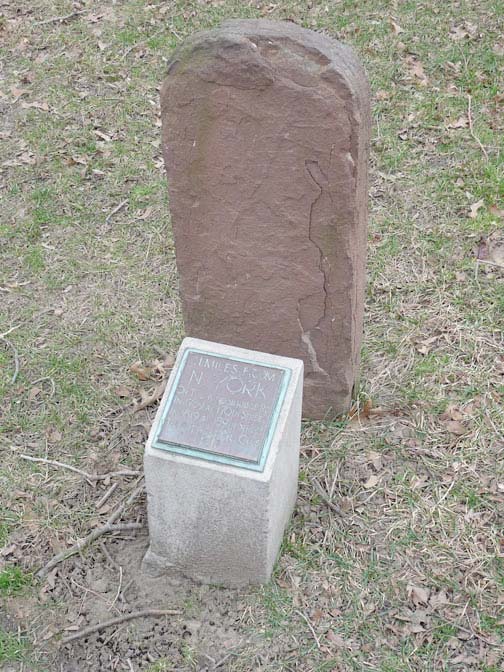
…and #11, with its lettering worn off as well, is in Roger Morris Park at the Morris-Jumel Mansion at Edgecombe Avenue and West 160th Street.
The old Post Road itself survives in the paths of the Bowery and 4th Avenue downtown, Broadway uptown, and in Van Cortlandt Avenue and Bussing Avenue in the Bronx. (Bronx’ Boston Road was built as a connector road to the Post Road in the 19th Century.) The old Post Road route is also followed along parts of US 1 into New england.

I’ve covered it before, but here’s a relatively newer relic from the 19th Century: a surviving gaslamp post at Broadway and West 211th, directly across Broadway from the mile marker. It is the sole survivor of NYC’s public street gaslamps except for another one in Patchin Place in the Village, and every time I see it I marvel that a truck hasn’t plowed into it and it’s still there.

The Isham Park entrance features a row of Type A park lamps, which are rarer than their Type B cousins. The main difference between A and B is that the A shafts are taller.
Like other parks in northern Manhattan, the site of Isham Park played a crucial role in the battle of Fort Washington during the American Revolution. The site served as a landing point for Hessian troops coming up the Harlem River to drive the American forces to Westchester and New Jersey.
In 1864 William B. Isham, a wealthy leather merchant, purchased twenty-four acres along the Kingsbridge Road, now known as Broadway, from 211th Street to 214th Street, and northwest to Spuyten Duyvil Creek.
The park originally included the old Isham mansion, stables, and green house, with the mansion located at the summit of the hill. Julia Isham Taylor donated a six-acre parcel of her estate to the city in remembrance of her father in 1912. She wanted the estate’s views of the Hudson and Harlem Rivers, the Harlem River Ship Canal, and Spuyten Duyvil to be preserved for future generations to enjoy. Julia’s daughter, Flora, donated her portion of the estate to the city in 1916. With Parks Department purchases in 1925 and 1927, the land for Isham Park was assembled. These acquisitions explain the unusual shape of the park which juts into Inwood Hill Park so that the two share a boundary in the middle of a field.
The mansion, stables and greenhouse proved too costly for the Parks Department to maintain and they were demolished in 1940.

Good Shepherd Church celebrated its 100th anniversary in 2012. The first church was a wood frame building that was moved across Cooper Street around 1930 and later razed to make way for an addition to the elementary school. When the IND subway reached Inwood in the early 1930s, the population increased, necessitating a bigger church, and the present Romanesque church was built in 1935 from Fordham gneiss mined in Manhattan and Bronx quarries.
On the Isham Street side of the church is an iron cross that was salvaged from the ruins of the World Trade Center after it was destroyed by terrorists 9/11/01. It was installed as a memorial garden at Good Shepherd Church on June 7, 2002.

Looking east on Isham Street you see the dome of the Gould Memorial Library, constructed in 1899 (Stanford White, architect) on the campus of what was New York University but is now Bronx Community College. Zooming in tight with the camera…

… you can see the colonnades of the Hall of Fame for Great Americans, where you will find busts of 98 of the country’s greatest politicans, scholars, teachers and authors, created by some of the country’s most noted sculptors. Even the name plates under the busts were made by Tiffany Studios.
Most of the names familiar from American history books can be found in the Hall, including Abraham Lincoln, Alexander Graham Bell, Samuel Morse, Robert Fulton; both Wright brothers and Thomas Edison are represented. There are several lesser-known figures such as astronomers Simon Newcomb and Maria Mitchell, first American Nobel Prize winner in science Albert Michelson, and anaesthetist William T. Green Morton.

At Broadway and Isham, on the same corner of Good Shepherd Church, is a 1910-1915 era FDNY alarm. It still has the shaft that held the fire alarm light, originally covered with clear red glass, later an orange plastic sphere.

Finally, in the 207th Street station itself is an old-fashioned track indicator that still gets the job done. It’s likely several decades old.
2/28/13

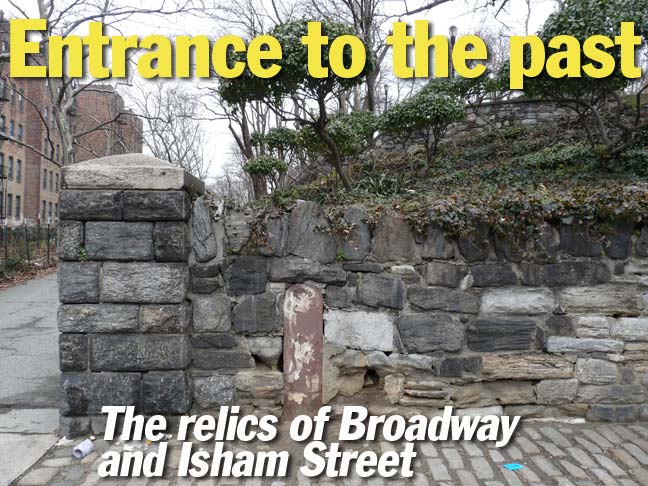
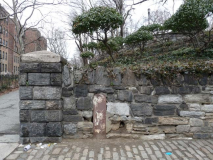
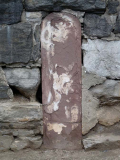
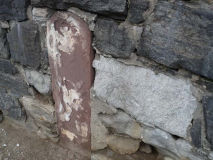
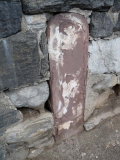

29 comments
Gould Library was used for part of a fake MIT in the Russell Crowe film “A Beautiful Mind”
Thanks for including the shot of the old NYU campus and its Gould Memorial Library. I am an alumnus. The interior of the Gould Library building was used to film scenes from the 1969 movies “Goodbye Columbus.”
nice read. so much research.
Just one thing, it IS pronounced “eye-sham”
I was at the bicentennial for Isham park, and relatives to the family were in attendance and pronounced their names like that.
Just to back up Art By Dj Boy, yes the descendants of Julia Isham Taylor, daughter of William Bradley Isham, said it is correctly pronounced EYE-sham, just as the new Parks sign says. Sadly the new sign miss-spells Ginkgo though!
Yep my last name is isham. We pronounce it with a long I although no one ever gets it right. I never even correct people anymore.
Thanks for clarifying the Isham pronunciation, I’ve been wondering!
Always fun checking in on your site. Just saw the post on the marker at the entrance to Isham Park.
Thought this post documenting the centennial of Isham Park might be fun for your readers. Good work keeping history alive. Cole Thompson
http://myinwood.net/inwoods-isham-park-turns-100/
So how do you feel Kosciusko should be pronounced? I go for Kah-CHOO-sko. I may be the only one & I’m not even sure why I say it that way! lol Everyone else seems to say kos-ki-OZ-ko.
Ko-SHUS-ko is close to the Polish pronunciation
Kosh-TSHUSH-ko is even closer.
KoskiOSko was the “traditional” Brooklyn way it was pronounced in my childhood…along with the Van Wick (with a short “i” – not Van Wike) Expwy. These changes in pronunciation are very confusing to us natives!
It’s not pronounced Kor-tel-you? How is it pronounced?
Kor-TELL-you
I LOVE your blog and I LOVE the respect you have for New York! One thing though, did you say that “Isham” is a one-syllable word? It’s a two-syllable word. For every separate vowel in a word – other than silent “E”s – there is a syllable…I-sham.
Forgive me if I misinterpreted – and again, great blog!
And by “separate vowel” I mean a vowel bookended by consonants.
There are several other gas lamp relics similar to the one you show on Broadway. To find them you have to go into the forest of Inwood Hill Park and walk the remnants of the old carriage paths that existed before the park was a park.
I believe those are simply Type B Bacon lamps that have been vandalized over the years — but if you see anything that looks like the Broadway gaslamp let me know.
This is my father’s old neighborhood, and I missed getting a chance to comment on the post about Dyckman Street and Broadway, so I’ll do so a little now…
Dad grew up there from 1928 to 1938. His father, Joe Lippman, owned a pharmacy at the corner of Payson Avenue and Dyckman Street, selling sodas and ice cream to people waiting to cross the Dyckman Street Ferry to New Jersey. The George Washington Bridge wiped that out and the Great Depression nearly wiped him out. After a while, their most reliable customer was Harry Houdini’s widow Bess, who came in regularly to buy buckets of tranquillizers to calm nerves made fragile by mediums, psychics, and charlatans all insisting they could connect her with the great magician’s spirit, if well-paid. When not golfing down tranquilizers, she bought and drank “medicinal alcohol” sold by Grandpa and bootleg whiskey.
The building the drugstore was in began to sink into a swamp, and the two buildings on Dyckman Street were prevented from collapsing together by a steel bar placed between them, which is still there. In 1938, Grandpa moved the drugstore to 186th Street and Amsterdam Avenue, despite the Depression…in spite of the New Deal efforts, the stock market took a major tumble that year.
The area owed its existence to the construction of the 8th Avenue Subway, and everyone called it, even decades later, “The New Subway” or “The Independent Subway.” If you lived in that courtyarded-building on the northwest corner of Dyckman and Broadway, with the covered subway entrances, you were considered to be the neighborhood’s upper crust.
At 214th Street and Broadway stood Manhattan’s last farm, a quarter-acre plot that sold fresh vegetables until 1954. Occasionally, my grandmother would go there to buy fresh veggies, which were cheaper than at local markets.
The Depression was a terror for them…Grandma was sometimes on the phone, begging Con Ed not to turn off the power. When FDR declared the Bank Holiday in 1933, it saved their proverbial bacon…Grandpa had three days to raise enough money to clear the rent and utilities checks he’d written. Grandma worked at the Progressive Drug Company in The Bronx, filling daily orders from pharmacies across The Bronx and Upper Manhattan.
Payson Avenue was a hill, so it was the spot for Dad and his pals to go sledding in winter, of course. Across the street was an open space called “Billy Myers’ Yard,” and Dad did not know the provenience of this monicker. What he did know was that the various Indian (Native American) tribes that originally lived on Manhattan Island would have annual events in Inwood Park, and the highlight was the arrival of an Indian Princess. At a ripe young age, Dad was told that the Indian Princess was a hot young woman who took off all of her clothes under the full moon and danced around the campfire in the buff.
Dad, of course, went with his pals to sneak in to see this extravaganza of raw flesh, and sure enough, the Indian Princess turned up, arriving in a Model A Ford. The driver opened the door, and out popped this ancient crone in full regalia, bonnet, and headdress. She did not take off her clothes, nor did she dance around the campfire. She was, however, treated with immense respect by all attendees, and gamely presided over the function. They did have a campfire. No nude dancing.
Decades later, I got the book “You Must Remember This,” about life in Manhattan in the various old days, and it had a photograph of a grim-looking, ancient “Indian Princess.” I showed it to Dad. He stabbed at the photograph in a microsecond, and said, “That’s her.” He never forgot.
Two other major events of 1938 were the premiere of two films at the Dyckman Theater…”The sinking of the USS Panay” and “Reefer Madness.” Dad went to see the former, and waited all day, through the feature film, newsreel, cartoon, selected shorts, travelogue, and second feature. Just as the screen went dark and a sonorous voice told the audience they would now see actual footage of the sinking of the gunboat on the Yangtze River by Japanese aircraft, Dad felt a clap on his shoulder. It was Grandpa. “Where have you been all day?” Grandpa yanked Dad out onto Dyckman Street. The sun had set. It was dark. He didn’t see the sinking of the Panay for another 40 years, watching it with me on a TV documentary. At that time, Dad wondered what all the fuss was about, as the Japanese Type 95 biplanes swooped like mosquitoes over the hefty-looking gunboat, covered with awnings, ventilators, and funnels.
The second big movie was “Reefer Madness,” which was a short subject between two movies. Dad watched as fictional typical teenagers started smoking immense reefers and entered lives of crime and debauchery. With wild eyes, hysterical laughs, and crazed expressions, the kids played the piano loudly, got into fights, robbed stores, and killed each other. The movie ended with the drug peddler’s guilt-ridden moll killing herself.
Dad rushed out of the theater and to Grandpa’s drugstore, and babbled to his father about the horrible effects of marijuana. Grandpa, a pharmacist, knew the realities of marijuana, and stood somewhat dumbfounded by the scenario Dad laid out. Then Dad blurted out, “I’ll never smoke that stuff!” Grandpa popped out of his reverie and said, in his best father-to-son voice, “That’s good, son. Very good. Don’t touch that stuff.” Dad didn’t.
Neither did I. But I did see “Reefer Madness” on TV about 30 years ago, and goggled at the heavy-handed plot and heavier-handed acting, and readily saw why Dad — a gentle man all his life — would be so upset at age 10 by the bizarre behavior of the movie. He was equally upset at age 22, when half of his rifle company was wiped out in a useless attack on a Korean cone named “Jane Russell Hill” in 1953, and did not talk about the slaughter of his friends for only 40 years.
Shortly after the “Reefer Madness” incident, the federal government released a schedule of drugs that were now illegal. Grandpa went through the list, found all the items in his drugstore, wrapped them up in a parcel, and handed the parcel to Dad. He obediently hopped on the IRT local at Dyckman Street, and carried the parcel down to the old US Army Building at Moore Street (where he was sworn in to the Army years later to fight in Korea), and gave the parcel to a federal official, who returned a receipt. The parcel contained quantities of marijuana, opiates, heroin, and morphia, with an impressive street value at the time and even today.
Decades later, Dad marveled at how casual it had all been…this parcel full of drugs was handed to a 10-year-old kid, who rode the subway to a building at the other end of Manhattan, and accepted with a receipt. He sat on the subway amid commuters, reading the Daily News and Daily Mirror about axe murderers and Mel Ott, with nobody aware of the value or peril of his parcel. Today — or even then — people might have shot him for it.
Thanks so much for the personal reminiscences of the neighborhood. The corner of Payson and Dyckman may have been a deli/bodega in 1972, when I started exploring my new upper Manhattan neighborhood. It was a laundromat for many years and became a seafood restaurant a few years back (apparently a victim of the pandemic). Years ago, I was told that a single family house, still on Seaman Ave between Academy and Cumming, was the “Houdini House”. I later found out that there was no Houdini connection, but there was a house on Payson that was the home of a member of Houdini’s family, but I believe it was an aunt or his mother and not his widow. I have no idea if that was the case or if it was indeed his widow, but that was what was passed along to me some years ago.
When I came to Inwood, there was a movie house on Dyckman, just east of Broadway and it was called the Alpine. There are still buildings on Dyckman that have the appearance of a former existence as a theater. Do you know if the Dyckman Theater that showed Reefer Madness became the Alpine or if it was another movie house further to the east? As I mentioned in another comment below, the closing of the several movie theaters in Inwood was the sign of a significant shift in the sociological aspects of the local neighborhood (as it did so many places elsewhere).
I so enjoyed your article about the origins of Isham Park. I had long wondered about it. My brother is coming to visit this fall, and I think that we shall make a pilgrimage up to Isham Park.
Awesome post. I too love learning NYC history and will eventually read all of your posts and go on a tour.
I’d like to know if you’ve ever researched Washington Terrace in Washington Heights on 186 Street between Amsterdam and Audubon Avenues. I grew up in Washington Heights, but didn’t know about this quaint area until a few years ago. I hear it could be in danger of being destroyed by Yeshiva University! A group of us on Facebook “I Grew Up In Washington Heights” are trying to do what we can to bring awareness to Washington Terrace and the history there. We’ve also contacted the NYC Landmarks Preservation Commission. I’m wondering if you’d visit, research, photograph and write a post about Washington Terrace.
Thanks!
[…] writers aside, it’s also notable for having the last (or second to last) gaslight lamp post in New York City, of which there were originally thousands. This one, in a […]
[…] in an easy-to-miss gated community in Greenwich Village, is actually the oldest working gas lamp (or second oldest) in New York City. It miraculously survived the mass replacement of the thousands of gas lamps in […]
My mother’s maiden name was Isham so I know it definitely is
pronounced Eye-sham. I have visited the Isham Hall in Northhamptonshire,
England. It is named Lamport Hall. Now I need to visit Isham Park in
Manhatton, New York.
Henry Kissinger used to live in the 207 St. as a child growing up.
my family lived on W 211th street from 1941-1970s. I left in 1951… Do any of you know the smoke/magazine/newspaper shop that was next to the Isham Pharmacy? It was owned and run my a couple of men last names: Wolf and Gershon.
Monroe,
In the 49 years I have lived in Inwood, the business space on the corner of Isham and Broadway has gone from a pharmacy (I believe sometime in the early 2000’s) to a frozen yogurt place (still seen on google maps street view), to a temporary home for Dichter’s Pharmacy after it was burned out of its longtime home near to 20th Street and is now a tattoo parlor. There is still a tiny newsstand wedged in between the parlor and Grandpa’s Pizza. I have no idea how long ago Wolf or Gershon were in charge there, but I would be surprised if they or their descendants are still involved with it. Even so, the newsstand is definitely one of the few spaces still doing the same business as they were in 1951. Much of the change is due to the coming of chains. None had set down anywhere in Inwood until sometime in the 1980s or 90s (technically excepting the Pathmark Pharmacy and A & P grocery – now a still a supermarket but a C-Town for many years – on Broadway between 204th and 207th). Since then, we have seen (two) MacDonalds, Starbucks, Domino Pizza, Kennedy Fried Chicken, Duncan Donut appear (and, in some cases, disappear). Most of the independent restaurants, stores and services have morphed from German/Jewish and Irish to Puerto Rican and then Dominican. Aside from the advent of the chains, the decline of the local focus of the community can be tied to the closing of the neighborhood movie theaters (two or three in the 1950s).
I remember the shop/ Often bought the World Telegram there. Also sold various trinkets. Once bought a girl friend a pin (lily in probably fake ivory and gold) there, and told her I bought it as Wolf’s, except I said in Washington for some reason.
I lived on Seaman Avenue, corner of 215 St from 1943 to 1965, with my mother Mildred and aunt Edith, until Edith married Art and took a different apartment in the same building. EYE sham street just a block away. Got caught sneaking into Baker Field once when I was 10, but later went as a Columbia student and alumnus legally. Drove there in 2020 just to show my wife where I grew up. Is the spring in the forest still potable, and the checkerboard/picnic site (originally created by the crews who built the Henry Hudson Bridge) still there? Wonderful area for a kid to grow up